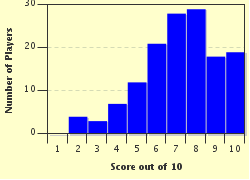Quiz Answer Key and Fun Facts
1. This dinosaur is very popular among kids and adults. Its ancestor also did the dino paddle. What monster from many movies, books and shows had some very small arms but a very large head and massive teeth?
2. What huge shark-like swimming creature from the age of the dinosaurs would have dwarfed a great white shark?
3. This smaller dinosaur (the swift plunderer) had very sharp claws as well as hook-like weapons on its back claws which it lashed out at with at its prey. What was its name?
4. What dinosaur had a very long tube that extended from the back of its head like a snorkel?
5. This is a flying reptile which had very light and delicate bones and was around for many of the millions of years that dinosaurs existed.
6. Baryonyx was a dinosaur with a long crocodile-like snout and nearly foot-long claws. It may have hunted with these claws by river beds much like what modern animal?
7. Kronosaurus was a sea reptile which used what to move forward?
8. Triceratops lived about the same age as which other ferocious dinosaur?
9. This fearsome dinosaur may have hunted in packs and had an almost foot-long claw on each of its back feet as well as smaller claws on its arms. What was the name of this dinosaur whose fossil was first discovered in the US in 1975 and was identified as a separate species in 1991?
10. What dinosaur was the size of a bus, had a brain the size of a walnut, may have had a second "brain" near its tail, and had 17 bony plates on its back?
Source: Author
Taltarzac
This quiz was reviewed by FunTrivia editor
NatalieW before going online.
Any errors found in FunTrivia content are routinely corrected through our feedback system.

